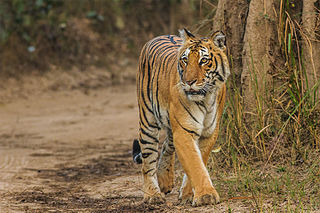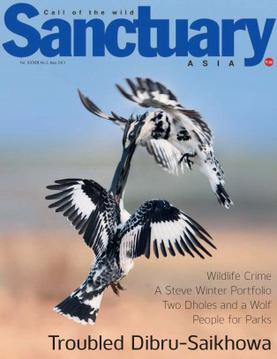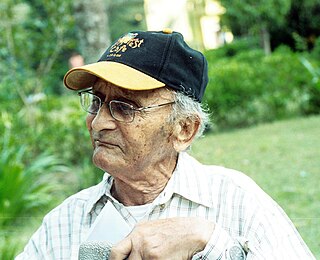Related Research Articles
Project Tiger is a wildlife conservation movement initiated in India to protect the endangered tiger. The project was initiated in 1973 by the Ministry of Environment, Forest and Climate Change of the Government of India. As of March 2024, there are 55 protected areas that have been designated as tiger reserves under the project. As of 2023, there were 3,682 wild tigers in India, which is almost 75% of the world's wild tiger population.

The Bengal tiger or Royal Bengal tiger is a population of the Panthera tigris tigris subspecies and the nominate tiger subspecies. It ranks among the biggest wild cats alive today. It is estimated to have been present in the Indian subcontinent since the Late Pleistocene for about 12,000 to 16,500 years. Its historical range covered the Indus River valley until the early 19th century, almost all of India, western Pakistan, southern Nepal, Bangladesh, Bhutan and southwestern China. Today, it inhabits India, Bangladesh, Nepal, Bhutan, and southwestern China. It is threatened by poaching, habitat loss and habitat fragmentation.

Jim Corbett National Park is a national park in India located in the Nainital district of Uttarakhand state. The first national park in India, it was established in 1936 during the British Raj and named Hailey National Park after William Malcolm Hailey, a governor of the United Provinces in which it was then located. In 1956, nearly a decade after India's independence, it was renamed Corbett National Park after the hunter and naturalist Jim Corbett, who had played a leading role in its establishment and had died the year before. The park was the first to come under the Project Tiger initiative.

Kenneth Douglas Stewart Anderson was an Indian writer and hunter who wrote books about his adventures in the jungles of South India.

Edward James Corbett was an Anglo-Indian hunter, tracker, naturalist and author. He was frequently called upon by the Government of the United Provinces of Agra and Oudh to kill man-eating tigers and leopards that were attacking people in the nearby villages of the Kumaon and Garhwal Divisions. He recounted his hunts and experiences in books like Man-Eaters of Kumaon, which enjoyed critical acclaim and commercial success. He was also an avid photographer and spoke out for the need to protect India's wildlife from extermination. In his honour, the Indochinese tiger subspecies has the scientific name Panthera tigris corbetti.

Valmik Thapar is an Indian naturalist, conservationist and writer. He is the author of 14 books and several articles, and has produced a range of programmes for television. Today he is one of India's most respected wildlife experts and conservationists, having produced and narrated documentaries on India's natural habitat for such media as the BBC, Animal Planet, Discovery and National Geographic.

Kailash Sankhala was an Indian biologist and conservationist. He was the director of Delhi Zoological Park and chief wildlife warden of Rajasthan. He is best known for his work in preserving tigers. Sankhala was the first director of Project Tiger, a conservation programme set up in India in 1973. He was well known as "The Tiger Man of India". He was awarded the Padma Shri in 1992 and Rajasthan Ratan in 2013.

Ramnagar is a town and municipal board in the Nainital district of Kumaon in the state of Uttarakhand, India. It is located approximately 65 kilometres (40 mi) from Nainital, the headquarters of the district.

The Indian leopard is a subspecies of the leopard widely distributed on the Indian subcontinent. It is threatened by illegal trade of skins and body parts, and persecution due to human-leopard conflict and retaliation for livestock depredation.
Evelyn Arthur Smythies, CIE, was a distinguished forester and philatelist, born of British parents in India. Smythies was an expert on the ecology of Uttarakhand and Nepal. His careful studies of the earliest postage stamps of India, Jammu and Kashmir, Nepal, and Canada produced groundbreaking handbooks on which philatelists rely, even today.

Sanctuary Asia is an Indian nature and wildlife conservation magazine founded in 1981 by Bittu Sahgal, its current editor. The magazine expanded in 2015 to become established as a non-profit foundation.

Kunwar "Billy" Arjan Singh was an Indian hunter turned conservationist and author. He was the first who tried to reintroduce tigers and leopards from captivity into the wild.

Tiger attacks are a form of human–wildlife conflict which have killed more humans than attacks by any of the other big cats, with the majority of these attacks occurring in Bangladesh, India, Nepal and Southeast Asia.

The National Tiger Conservation Authority (NTCA) is a wildlife conservation agency formed to protect the endangered Bengal tiger in India. It was established by the Government of India in December 2005 for the management of Project Tiger and the various tiger reserves in India. As of 2023, there were 3,682 wild tigers in India, which is almost 75% of the world's wild tiger population.
Romesh Thapar (1922–1987) was an Indian journalist and political commentator. Affiliated with the Communist Party of India (Marxist), Thapar was the founder-editor of the monthly journal Seminar, published from New Delhi, India.

General Pran Nath Thapar was the fourth Chief of Army Staff of the Indian Army. The Sino-Indian War was fought during his term, in which the Indian Army fared poorly. Thapar resigned during the last stages of the war, handing charge to Lt. Gen. J. N. Chaudhuri.

Bittu Sahgal is an environmental activist, writer, and the founder of Sanctuary Nature Foundation, an Indian nonprofit conservation organization that works on environmental policy, advocacy, science, on-ground support and habitat management. He is also the founding editor of Sanctuary Asia, a wildlife and ecology magazine.

The Wildlife Protection Society of India (WPSI) was founded in 1994 by Belinda Wright, its Executive Director, who was an award-winning wildlife photographer and filmmaker till she took up the cause of conservation. From its inception, WPSI's main aim has been to bring a new focus to the daunting task of tackling India's growing wildlife crisis. It does this by providing support and information to government authorities to combat poaching and the escalating illegal wildlife trade - particularly in wild tigers. It has now broadened its focus to deal with human-animal conflicts and provide support for research projects.
Saroj Raj Choudhury was an Indian environmentalist, wildlife conservationist, writer and the first Forest Conservator under the Government of Odisha. He was also the founder director of the Simlipal National Park, in the Mayurbhanj district in the Indian state of Odisha. Choudhury was known for the pugmark technique he employed for tiger census and for his comradeship with Khairi, a domesticated tigress. His experiences with the animal has been documented in a book, Khairi: The Beloved Tigress, written by him and published in 1977. The Government of India awarded him the fourth highest Indian civilian honour of Padma Shri in 1983.
Aditya 'Dicky' Singh was an Indian wildlife conservationist and wildlife photographer.
References
- ↑ Indian Army List January 1919
- ↑ Indian Army List January 1919
- ↑ London Gazette 29 August 1922
- ↑ Thapar, V. (2001). Saving Wild Tigers, 1900-2000: the essential writings. Permanent Black, Delhi. p. 59 (Book Preview)
- ↑ Niyogi, C. (ed.) (2006). Reorienting Orientalism. Sage Publications, New Delhi ( ISBN 0761934472). pp. 210
- ↑ Rangarajan, M. (2006). India's Wildlife History: an Introduction. Permanent Black and Ranthambore Foundation, Delhi ( ISBN 8178241404). p. 72